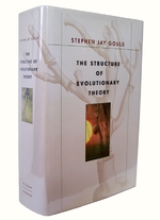
The Structure of Evolutionary Theory
Overview
The Structure of Evolutionary Theory (2002) is a technical book on macroevolutionary theory
by the Harvard
paleontologist
Stephen Jay Gould
, published only two months before his death. The volume is divided into two parts. The first is a historical study
and exegesis
of classical evolutionary thought
, drawing extensively upon primary documents. The second is a constructive critique of contemporary Darwinian theory
, and presents a case for a hierarchical
interpretation of biological evolution based largely on the author's theory of punctuated equilibrium
.
According to Gould, classical Darwinism encompasses three essential core commitments.
Macroevolution
Macroevolution is evolution on a scale of separated gene pools. Macroevolutionary studies focus on change that occurs at or above the level of species, in contrast with microevolution, which refers to smaller evolutionary changes within a species or population.The process of speciation may fall...
by the Harvard
Harvard University
Harvard University is a private Ivy League university located in Cambridge, Massachusetts, United States, established in 1636 by the Massachusetts legislature. Harvard is the oldest institution of higher learning in the United States and the first corporation chartered in the country...
paleontologist
Paleontology
Paleontology "old, ancient", ὄν, ὀντ- "being, creature", and λόγος "speech, thought") is the study of prehistoric life. It includes the study of fossils to determine organisms' evolution and interactions with each other and their environments...
Stephen Jay Gould
Stephen Jay Gould
Stephen Jay Gould was an American paleontologist, evolutionary biologist, and historian of science. He was also one of the most influential and widely read writers of popular science of his generation....
, published only two months before his death. The volume is divided into two parts. The first is a historical study
History of science
The history of science is the study of the historical development of human understandings of the natural world and the domains of the social sciences....
and exegesis
Exegesis
Exegesis is a critical explanation or interpretation of a text, especially a religious text. Traditionally the term was used primarily for exegesis of the Bible; however, in contemporary usage it has broadened to mean a critical explanation of any text, and the term "Biblical exegesis" is used...
of classical evolutionary thought
Evolution
Evolution is any change across successive generations in the heritable characteristics of biological populations. Evolutionary processes give rise to diversity at every level of biological organisation, including species, individual organisms and molecules such as DNA and proteins.Life on Earth...
, drawing extensively upon primary documents. The second is a constructive critique of contemporary Darwinian theory
Modern evolutionary synthesis
The modern evolutionary synthesis is a union of ideas from several biological specialties which provides a widely accepted account of evolution...
, and presents a case for a hierarchical
Unit of selection
A unit of selection is a biological entity within the hierarchy of biological organisation that is subject to natural selection...
interpretation of biological evolution based largely on the author's theory of punctuated equilibrium
Punctuated equilibrium
Punctuated equilibrium is a theory in evolutionary biology which proposes that most species will exhibit little net evolutionary change for most of their geological history, remaining in an extended state called stasis...
.
According to Gould, classical Darwinism encompasses three essential core commitments.

